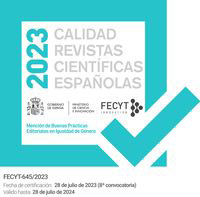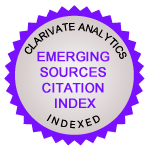Directrices para autores
El Consejo Editorial de la revista Investigaciones Turísticas, con el propósito de facilitar la presentación, evaluación y publicación de los trabajos, ha preparado la siguiente información y orientaciones. Por favor, lea completa y cuidadosamente todos los apartados de esta información y atienda cuidadosamente los aspectos que se señalan.
Investigaciones Turísticas no cobra tasas por el envío de trabajos, ni tampoco cuotas por la publicación de los artículos.
Para poder enviar trabajos a la revista, es necesario previamente registrarse e identificarse como autor, revisor y lector en el sitio web de la revista.
Se debe verificar que el texto enviado se atiene a las siguientes normas:
1. Los trabajos estarán escritos en castellano, inglés o portugués.
2. Se aceptarán dos tipos de trabajos:
- Artículos. Serán trabajos teóricos o empíricos originales, completos y desarrollados. Se primarán artículos con alto grado de originalidad en su enfoque, novedad en los métodos de investigación aplicados o en la temática. En cualquier caso, tendrán preferencia trabajos cuyos resultados supongan un avance significativo en el conocimiento científico del turismo. Se rechazarán envíos que traten exclusivamente casuísticas locales o donde primen estudios eminentemente descriptivos. Por otro lado, solo se aceptarán artículos de revisiones bibliográficas o de estado de la cuestión, cuando sean elaborados de forma rigurosa y aporten una visión novedosa y reflexiva que contribuya a la comprensión de la evolución de un ámbito del turismo.
- Reseñas Bibliográficas. Serán textos breves que comenten e informen críticamente sobre un libro o monografía en el ámbito del turismo. Las obras objeto de reseña han de haber sido publicadas en los últimos dos años.
3. Los trabajos enviados serán inéditos y no se podrán someter a la consideración de otras revistas mientras se encuentren en proceso de evaluación en Investigaciones Turísticas. Excepcionalmente, y por razones de interés científico y/o de divulgación de aportaciones especialmente notorias, el Consejo Editorial podrá decidir la publicación y/o traducción de un texto ya publicado. Asimismo, la publicación de varios trabajos firmados por un mismo autor tendrá una carencia mínima de un número.
4. El nombre, filiación institucional, datos de contacto y nota biográfica del autor o autora deben insertarse exclusivamente en el sistema informático de la revista. El documento de Word en el que se presenta el artículo no debe contener esta información. Se deberán cumplimentar los metadatos del trabajo en castellano e inglés. Debe prestarse especial atención a las referencias bibliográficas. Es indispensable la coincidencia entre las referencias bibliográficas incluidas en el artículo y las incorporadas en los metadatos. Si sucesivas revisiones del artículo modificaran la bibliografía, los autores deberán adecuar dichas referencias en los metadatos.
Todos los trabajos deberán enviarse anonimizados: se suprimirán todas las citas, agradecimientos y demás alusiones que pudieran permitir directa o indirectamente la identificación del autor/a. El Consejo Editorial de Investigaciones Turísticas se asegurará de que los textos cumplen con esta condición. Si el artículo o nota es aceptado para su publicación, se enviará entonces la versión no anonimizada a la revista, en caso de que difiera de la ya enviada.
5. Es obligatoria la cumplimentación del campo de ORCID en la ficha de autoría. La página ORCID de cada autor/a debe estar actualizada.
6. Los artículos tendrán una extensión mínima de 7.000 palabras y máxima de 10.000, incluyendo las notas al pie, título, resúmenes, palabras clave, gráficos, tablas y bibliografía. Sólo excepcionalmente, si el Consejo Editorial considera que existen razones justificadas por el interés científico del trabajo, se podrá modificar estos límites.
Las reseñas bibliográficas tendrán una extensión máxima de 2.500 palabras, y deberán especificar los siguientes datos de la obra reseñada: autor/a, título, lugar de publicación, editorial, año de publicación y número de páginas. Se deberá incluir también el nombre y apellidos, filiación institucional y dirección electrónica del autor/a de la reseña.
7. El texto de los artículos irá precedido de un título, un resumen con un mínimo de 250 palabras (que expondrá clara y concisamente los objetivos, metodología, principales resultados y conclusiones del trabajo) y de un mínimo de 6 palabras clave. Se añadirá el título, el resumen (abstract) y las palabras clave (keywords) en inglés. Es responsabilidad de los autores cuidar de la calidad del texto en inglés, pudiéndose requerirles su corrección. Traducciones incorrectas pueden conllevar el rechazo del trabajo. Asimismo, los envíos en inglés o portugués, deberán incorporar el título, resumen y palabras clave también en castellano.
8. El formato del texto deberá respetar las siguientes normas. Serán archivados los envíos que no cumplan con el formato descrito:
- El archivo de envío está en formato OpenOffice, Microsoft Word, RTF o WordPerfect.
- El título del artículo será en tipografía Calibri, tamaño 14, minúscula y centrado en el texto.
- La letra del texto será en tipografía Calibri, tamaño 12.
- El texto irá justificado, con interlineado sencillo y sangría en primera línea en 1.25 cm.
- Los márgenes serán de 2,5 cm, tanto superior-inferior como izquierdo-derecho de la página.
- Las páginas irán numeradas al pie, en la parte inferior derecha.
- Las notas irán numeradas consecutivamente al pie de página. Se recomienda reducir su uso al máximo y que ese uso sea explicativo y nunca de citación bibliográfica.
- Las secciones o apartados del texto se jerarquizarán siguiendo el siguiente orden: 1º) Numeración romana, mayúscula y negrita (I. MAYÚSCULA Y NEGRITA); 2º) Numeración arábiga, minúscula y negrita (1.1. Minúscula y negrita); 3º) Numeración arábiga, minúscula y cursiva (1.1.1. Minúscula y cursiva); 4º) Letra minúscula, minúsculas y normal [a) Minúsculas].
9. Todos los elementos no textuales (tablas, mapas, gráficos, figuras, etc.) deberán aparecer enumerados con números arábigos, en el orden en el que se mencionan en el texto y se designarán como Tabla 1, Figura 1 o Gráfico 1. En la parte superior llevarán un título conciso y claro y se especificará al pie su fuente de procedencia.
Las imágenes, dibujos, fotografías, figuras, tablas, gráficos, etc. que ilustran los artículos deberán ser obra de los autores o autoras del artículo o, en caso contrario, deberán estar libres de derechos, o bajo licencias Creative Commons que permitan su reutilización e indiquen los usos que pueden hacerse de estos. Si se utilizasen imágenes, gráficos, etc. protegidos por derechos de autor se deberán haber solicitado y obtenido la autorización de los creadores o creadoras de dichas imágenes, gráficos, etc.
10. Normas para citas y referencias bibliográficas.
- La revista adopta y se adhiere a las normas de publicación establecidas en la 7.ª edición del manual de estilo de la American Psychologial Association (APA).
- También puede consultar la guía de estilo APA (PDF), elaborada por la Biblioteca de la Universidad de Alicante.
- Todas las referencias bibliográficas que tengan DOI (Digital Object Identifier) lo indicarán al final, con formato de enlace URL completa y segura, sin prefijos ni punto al final. Se puede comprobar el DOI de una lista de referencias en la página Simple Text Query de Crossref.
11. Una vez superada la primera ronda de evaluación por los revisores y si solicitan mejoras en el artículo, los autores dispondrán de un plazo de dos meses para enviar la nueva versión. El incumplimiento de estos plazos conllevará el archivado del envío.
12. MUY IMPORTANTE. Las versiones revisadas de los trabajos incluirán un documento al final del texto redactado, donde se explique sistemáticamente cómo se han resuelto las cuestiones planteadas por los revisores. No se aceptarán envíos que no cumplan este requisito. Para ello:
Ese documento tendrá el siguiente formato:
- Cree una tabla con 2 columnas.
- En la columna 1, corte y pegue en celdas individuales cada comentario realizado por cada revisor, así como los requisitos indicados por el Editor en el correo electrónico de decisión.
- En la columna 2, facilite una explicación y justificación de su perspectiva e indique con precisión y claridad qué cambios ha realizado en el manuscrito. Muestre los cambios en el texto de esta columna o proporcione una indicación clara de la sección y las páginas donde se pueden encontrar los cambios en el manuscrito revisado.
- Si no está de acuerdo con los comentarios o sugerencias de los revisores, o prefiere un enfoque alternativo para abordar un problema planteado, debe discutir y explicar sus puntos de vista y justificar el enfoque elegido.
Su manuscrito revisado debe identificar claramente todos los cambios de la versión anterior. No debe utilizarse el control de cambios. Cambie el color de los párrafos, líneas o palabras modificadas.
13. Todas/os las/los autoras/autores deberán haber realizado aportaciones significativas al trabajo presentado. La autoría debe incluir y limitarse a aquellos/as autores/as que han contribuido sustancialmente al trabajo. El orden de firma deberá basarse en la importancia de la aportación realizada por cada uno de los autores tomando en consideración criterios como: 1) la concepción original del trabajo; 2) el análisis, adquisición e interpretación de los datos, 3) la redacción y revisión crítica del contenido y; 4) la aprobación final de la versión a publicar.
Los/las autores/autoras indicarán, en la versión última del mismo y una vez se haya aprobado para su publicación, al final del artículo, en un apartado denominado Contribuciones de las/los autoras/res -tras las referencias bibliográficas-, cual ha sido la contribución de cada uno/a al trabajo. Un/a autor/a, además de ser responsable de las partes del trabajo que haya elaborado, debe ser capaz de identificar a quien corresponde la autoría de otras partes específicas del trabajo.
14. A continuación de la autoría, en un punto identificado como Agencias de apoyo, las/los autoras/es deberán indicar la(s) agencia(s) de financiación y el (los) código(s) del (los) proyecto(s) en el marco del (los) cual(es) se ha desarrollado la investigación que ha dado lugar a la publicación.





